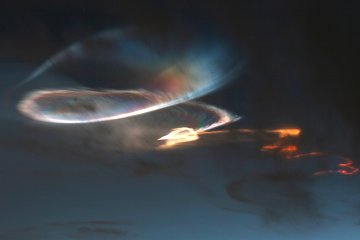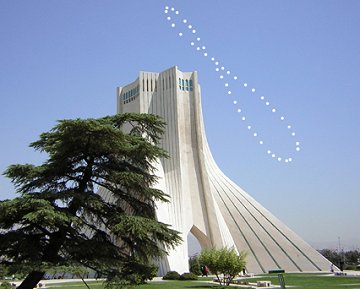 Did you miss the rocket launch? Next time get a phone alert: Sign up for SpaceWeather PHONE.
Did you miss the rocket launch? Next time get a phone alert: Sign up for SpaceWeather PHONE.
ROCKET LAUNCH: A Minotaur rocket blasted off from Vandenberg Air Force Base near Los Angeles on Sept. 22nd, creating a sunset vapor display that amazed onlookers all the way from southern California to Arizona. "It was spectacular! My mom saw it, too, and she was thrilled," says Mike Sinnott of Phoenix, AZ. "Thanks for the phone alert."
At NASA's Table Mountain Observatory near Wrightwood, CA, James W. Young snapped this picture of the rocket's exhaust twisting in the wind:

What causes the pearly colors? Water droplets and bits of unburnt fuel from the rocket's exhaust freeze in the cold upper atmosphere. When sunlight hits the icy crystals, they glow pastel yellow, red and blue--a phenomenon known as iridescence.
more images: from Mike O'Leary of El Cajon, CA; from Dennis Mammana of Borrego Springs, CA; from Derrick Lim of Tempe, AZ; from Joe Cahak of Ramona, CA;
ANALEMMA: If you took a picture of the Sun at the same time each day, would it remain in the same position? The answer is no, and the figure-8 traced out by the Sun over the course of a year is called an analemma:

The analemma above was created by Iranian astronomer Mohammad Reaza Noroozi. Using a single piece of film, he painstakingly photographed the sun on 45 mornings spanning two years, 2003-2005. The picture was completed with a single exposure of the foreground, a beautiful building in Tehran.
The upper and lower tips of the "8" represent the solstices--the longest and shortest days of the year. Midway between the tips are the equinoxes--when day and night are of equal length. The autumnal equinox, marking the beginning of northern autumn, was yesterday, Sept. 22nd.

